Deck Design 101- A Guide to Deck Building!
Hi there! I told you I’d be back with another weird deck – and on that front I won’t disappoint – but I thought I’d do things a little differently this time. An important part of the Pokemon TCG and the very reason articles like this can even exist, is the creative freedom available to us as players when it comes to which cards we choose to play with. There are hundreds and hundreds of cards in the available card pool and we can use up to four of each of them in our 60 card deck. It doesn’t take a mathematician to see that the number of possible decks one can make is some ludicrously high number with a lot of zeroes.
It’s because of this, that some players can feel understandably overwhelmed when it comes to putting their decks together. There are so many options it can be hard to tell where to even start! Not just new players either – from seasoned players to returning vets, sometimes people just prefer the safety of imitating a deck that’s already proven successful over trying to create a new strategy that may not work. You have a lot to gain from learning how to approach deck building, however. By knowing how your deck is constructed and why, you will have a deeper understanding of the game as a whole, and be able to formulate better strategies in-game. By experimenting with new things, you are contributing to the ever-shifting metagame which helps keep our beloved TCG healthy and competitive!
So today, we’re going to look at a weird, quirky deck, but I’m not just going to tell you how the deck works and what I decided to put in it. I’m going to break down the entire deck building process step-by-step, starting from choosing one card you’d like to use, to having a full 60 card deck list.
Step One: Getting to Know the Cards
I know a lot of players feel intimidated when they hear people talking about “the metagame.. It sounds like a very technical term and it gets thrown around a lot in discussions regarding high-level play. The truth is, “the metagame” is actually just a faster way to describe two fairly simple concepts:
- What cards are currently available to be played
- Which of those cards are most commonly being used by players
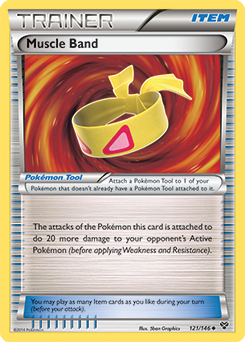
The first part of that equation is pretty easy to figure out. The most commonly played competitive format is the Standard format. It’s a format that consists of the most recently released expansions. As of the writing of this article, the Standard format consists of any card from Boundaries Crossed to Roaring Skies. So the first part of understanding what the metagame consists of familiarizing yourself with that group of cards. If you’re a new or returning player who doesn’t particularly feel like taking the time to look over several thousand cards, a good place to start is simply looking over the rare Pokemon, Trainers and Special Energy in each set. Common and uncommon Pokemon rarely have any impact on the metagame (with a few exceptions) and typically fall into the category of “filler” cards. This way you’ll at least have an idea of what cards you may encounter as well discover what cards you would like to use yourself.
The second part is a little trickier. Figuring out what decks other people are using is going to take a bit of research, but is equally as essential to the deck building process. PokeBeach happens to have a Metagame Deck Discussion forum, where you can find deck lists and competitive discussion on all of the most popular and powerful decks players use at tournaments. Besides that, our other free and premium articles, the TCG Competitive Play, Deck Garage, and TCG Journals & Reports forums, live competition streams, and YouTube videos made by other players are great ways to see the kind of decks other people are using in action. As we’re going to explore in more detail shortly, the kinds of cards other people are using the most is going to have a fairly large effect on how well the cards you choose to play can perform. Knowing what to expect from other players in a competition is a very important first step in figuring out how to defeat them.
That’s the metagame in a nutshell. Just learning what cards are usable and which are seeing play. Once you think you’ve explored these aspects enough and have a feel for the competitive environment, it’s time to choose a card or strategy you’d like to play and move onto the next step of the deck building process.
Step Two: Identifying a Card’s Strengths and Weaknesses
To help demonstrate how to apply the knowledge you gained in the previous step to actual deck building, we’re going to build a deck together based around a specific card that appears to have some potential.
Say hello to Heracross-EX.
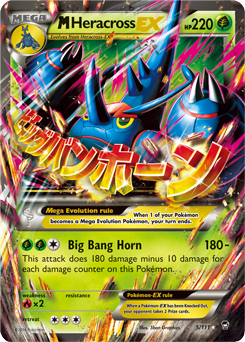
Wow. Look at that HP. That attack power. Those numbers are pretty high numbers compared to some of the other Pokemon you’ve seen and the drawback of his attack sounds pretty manageable. This guy is going to be the foundation of our deck. Before we can start building around him though, we need to compare him to other cards seeing play and weigh the pros and cons of each of his attributes.
Positives
- He has 220 HP. He’ll be hard to take down and getting a OHKO on him will be particularly difficult.
- He’s capable of hitting for 180 damage at full HP. That’s enough to OHKO any non-Mega Pokemon in the game.
- He’s a grass type. In your metagame scouting, you probably noticed a very large amount of decks playing Seismitoad-EX, who is weak to Grass. That’s a good thing.
- His Weakness is Fire. There aren’t a lot of big Fire decks being played right now, so Weakness won’t be much of an issue. It’s very unlikely Heracross-EX will be OHKO’d.
Negatives
- While manageable, he does have less power while damaged.
- His attack requires three Energy attachments.
- His retreat cost is quite high at three Energy.
- He’s a Mega Pokemon with no Spirit Link. You will always have to give up a turn to Mega Evolve.
Now that we have a grasp of the ups and downs that come with the backbone of our deck, it’s time to start gathering the other pieces of the deck.
Step Three: Selecting Partners that Compliment the Card
Heracross-EX on his own has faults that could make him difficult to use, so a good place to start would be selecting partners that can mitigate those faults. Let’s break down what cards we’d select for this deck in particular and why
The Energy Issue
Heracross-EX needs three energy attachments to attack. Combined with the lost turns to Mega Evolve, that’s going to make this deck very slow. In addition, most decks you’ll be competing against are able to power up a primary attacker in just one or two attachments.
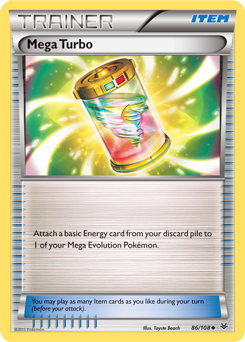
Virizion-EX is my first pick. Emerald Slash gets two Grass Energy from the deck onto a Benched Heracross. That will speed up the process significantly. Verdant Wind is a nice Ability as well, keeping Poison off Heracross-EX and preventing additional crippling damage.
Mega Turbo is an option as well. It’s an Item card that lets you move an Energy from your discard pile to any Mega Pokemon you have in play. It’s a quick way to break free of the one-Energy-per-turn restriction.
Keeping M Heracross Undamaged
Dusknoir from Flashfire is a great choice to pair with Heracross-EX. It’s Shadow Void Ability can move any damage counters from one of your Pokemon to Dusknoir, which means moving them off of Heracross so his attack does as much damage as possible.
Max Potion goes hand in hand with this strategy. It fully heals a Pokemon at the expense of discarding all Energy on that Pokemon. Using it on a Heracross-EX would be a bad idea after we worked so hard to speed Energy onto him in the first place, but Dusknoir just sits Energy-less on the Bench using the Ability. This card is great for healing that damage away, so he can continue using Shadow Void to sponge more damage from Heracross.
Super Potion is a card that doesn’t see much play but I feel definitely has a place in this deck. Removing 60 damage in exchange for discarding one Energy, it can be used without cost on Dusknoir (similar to Max Potion) but can also be used directly on Heracross himself if Dusknoir is not available. It has some nice synergy with Mega Turbo, which would let you immediately reattach the Energy you discarded to play this card.
Herbal Energy almost seems like it was designed with this deck in mind. It’s a Special Grass Energy that heals 30 damage from any Grass Pokemon you attach it to. This is a good way to heal a little extra damage off a Heracross while also powering it’s attack.
Pokémon Center Lady is another great option. Seismitoad-EX is still a popular card so we’ll need to have options prepared that will allow this deck to still function under Item lock. Pokémon Center Lady certainly isn’t going to keep you running full speed while under the effects of Quaking Punch, but it’s good to still have options.
So with what we’ve gathered so far, our skeleton deck list should look something like this:
Pokemon (?) |
Trainers (?) ?x Pokémon Center Lady (FLF #93)
|
Energy (?) |
We have our strategy picked out and the foundation of a deck ready to go, but how do we decide how many of each card to play? And what other cards do we fill the deck out with? That’s where the next step comes into play.
Step Four: Understanding Consistency
“Consistency” is a term we use to refer a deck’s ability to actually pull of it’s intended strategy during each game it plays. Yes, your Dusknoir can keep taking damage off of M Heracross-EX so he’s doing 180 damage every turn, but how often are you going to be able to get those Pokemon into play without being overrun by your opponent first? That’s where consistency cards come into play. These are the cards that speed up your deck, getting the cards you need into play faster. This includes cards that let you draw more cards from your deck, as well as cards that let you search your deck for something specific. These are the crucial cards you will want to be playing every turn from the get-go. A deck’s worth can often be measured by it’s consistency!
For our build, here are some great consistency cards I’d choose:
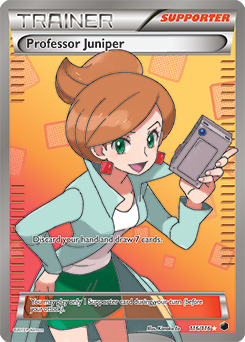
Professor Juniper / Professor Sycamore: Drawing a new hand of seven cards is great. There’s little else in the game that offers that kind of draw power from a single card. However, when playing this card, you have to be wary of overextending and throwing away valuable cards in the early stages of the game.
N: In the early game, this card works similarly to Professor Juniper – however, because it’s based on your number of Prizes remaining, the most it’ll let you draw is 6 cards. The flipside to this is that you won’t be forced to discard anything you might need later. Always keep the number of cards in your opponent’s hand in mind though – you don’t want to provide them with too much of an advantage by playing this card when it will give them access to extra resources as well.
Skyla: This card works well in most decks, but in a deck that relies on all sorts of Trainer cards like this one, Skyla really shines. Playing her lets you search your deck for any Trainer card you want. You need a Max Potion to heal off your Dusknoir? Or maybe even a Professor Juniper to ensure you can keep things moving along next turn? Skyla can do that.
VS Seeker: Do the above mentioned cards sound really useful to you? Well, you’re gonna love VS Seeker then, as it lets you take one of those cards back from the discard and use it again. With enough Supporters in your discard, this one card can provide an extraordinary amount of utility.
Ultra Ball: While drawing from your deck will certainly improve the likelihood of getting the Pokemon you need into play, Ultra Ball can guarantee it. For the cost of discarding two cards from your hand, you can take any Pokemon you need from your deck and put it into your hand.
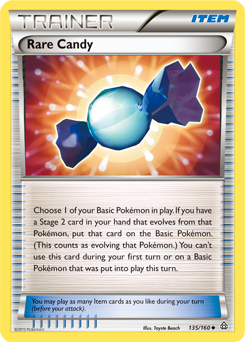
Rare Candy: This one’s a little trickier. It doesn’t allow you to draw anything you don’t already have in-hand, but what it does do is allow you to skip over the Stage 1 Pokemon and evolve a Basic directly into a Stage 2. This means you can go from Duskull to Dusknoir one turn sooner than you normally could! Even one turn can make a difference when you play a deck like this that requires a set-up to function properly
Computer Search: Discarding two cards from your hand for any one from your deck is never a bad deal. It could get you that crucial card you need when you need it.
Professor's Letter: Because Heracross needs three Energy to attack, you’re going to want to make sure you get your attachment every turn. This card will not only get Energy to your hand, but can even bail you out when you’re in need of Energy, but only have access to Skyla or VS Seeker.
Sacred Ash: Because we’re playing cards like Professor Juniper and Ultra Ball, there are going to be situations where we have to discard a Pokemon we still need. Sacred Ash can bring those Pokemon back to your deck. It’s also a great tool to use late-game when a bunch of your Pokemon have been Knocked Out.
Startling Megaphone: A good utility card in general that stops opponents from doing extra damage with Muscle Band or Silver Bangle. It doubles as a way of removing tools from Garbodor, which stops him from being able to use his Garbotoxin Ability – something that will really hurt this deck.
So now that we have a selection of cards to make everything run more smoothly, our deck list is going to look a little more like this:
Pokemon (?) |
Trainers (?) ?x Professor Juniper (PLB #84) ?x N (DEX #96) ?x Pokémon Center Lady (FLF #93)
?x Professor's Letter (TKXY #24) |
Energy (?) |
Now things are coming along and we’re starting to look like we have a real deck on our hands! The next step is replacing those question marks with actual numbers, which is exactly what we’re going to do.
Step Five: Balancing Your Deck
Anybody who has played Pokemon Trading Card Game Online may be familiar with something called the Deck Wizard. Among a multitude of poor decisions this clown of a virtual deck builder is known for is the fact that all the decks he constructs have a perfect 20 / 20 / 20 split of card types. That’s 20 Pokemon, 20 Trainers, 20 Energy. You only need to play one deck like this to realize exactly why that’s not a good idea. So what is a good ratio of cards?
Well… that depends on the deck! As a general rule of thumb, you are almost always going to have more Trainer cards than anything else in your deck. Trainers are the lifeblood of the deck that make everything work, so you’re going to want plenty of them. You’re going to want multiples of the cards most valuable to your deck’s consistency, both to let you use them multiple times, and to improve your odds of drawing into them when you need them.
Balancing your deck like this is something that’s best demonstrated, so let’s look at our Heracross deck again:
Pokemon
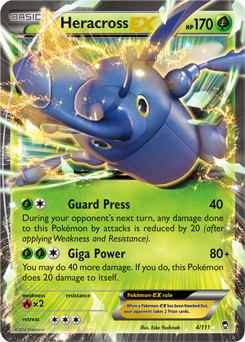
Heracross-EX and M Heracross-EX – 3 / 2 : I’ve decided to run three copies of Heracross-EX and two M Heracross-EX. We’ll need three Heracross-EX to make sure we get one into play early enough. We’re only going to run two of the Mega because this deck is already slow as it is, so the likelihood of us getting more than two turn-ending Mega Evolutions off in a game is pretty unlikely.
Virizion-EX – 2: You’ll probably only end up using one Virizion-EX in any given game, but his Emerald Slash is pretty crucial to our set-up, so running two increases our odds of starting with one as well as decreasing the chances of all our copies winding up lost in the Prizes.
Duskull / Dusclops / Dusknoir – 3 / 1 / 3 : Three Duskull and three Dusknoir make sense, as we’ll be using Rare Candy to skip the Stage 1, but what’s with that one Dusclops? Well, there are going to be situations where you don’t have access to Rare Candy, either due to not being able to draw one, or being under the effect of Item lock. The Dusclops simply provides an alternate means of going from Duskull to Dusknoir, even if it is a slower one. Options are always good.
Trainers
Professor Juniper / N – 4 / 4 : Drawing cards is good. Running the maximum amount of these is a no-brainer.
Skyla – 2: We’ll run two of these, since we rely on so many different Items. Being able to grab the ones we need when we need them will be wonderful. Any more than two should be unnecessary, since Skyla is of more situational use than a draw Supporter, and we always have VS Seeker if we’d like to use Skyla more than two times.
VS Seeker – 3: Again, VS Seeker is a card unrivaled utility. We’ll want to run a bunch to make sure we get the most out of our Supporters.
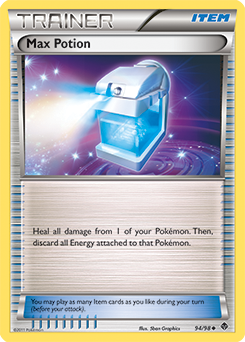
Max Potion – 3: Having lots of these will be great. We won’t run the full amount because we’ll need room for other healing options as well.
Super Potion – 2: It’s slightly less useful than Max Potion overall, so we’ll run less. However, it can still be very useful in a lot of situations, so it deserves more than one slot in our deck.
Pokémon Center Lady – 1: Again, this card is a bit situational, and we have VS Seeker, so we only need one.
Mega Turbo – 2: This one’s a toss-up. I’d like to say running three is a good idea, but I feel there just isn’t enough space, and that there just aren’t enough opportunities you’d need to play one to warrant running more.
Rare Candy – 2: Two Duskulls that won’t have a Stage 1 to evolve from, two Rare Candy. Nice and simple.
Ultra Ball – 4: Gotta catch ’em all. You want to get your Pokemon out consistently.
Everything else I mentioned will sit at one copy. That puts us at 45 cards. I’d like to leave a few slots open for discussion, so we’ll jump that number up to 50, meaning we have room for 10 Energy cards. Here I would most likely run eight Grass and two Herbal Energy. The healing effect of Herbal Energy is useful, but it’s Special Energy nature means it’s susceptible to Enhanced Hammer. Also, Emerald Slash, Mega Turbo and Professor’s Letter only allow us to grab basic Energy cards, so we’ll need to favor them.
That means we now have a (mostly) complete deck list, and it looks like this:
Pokemon (14) |
Trainers (31) 4x Professor Juniper (PLB #84) 4x N (DEX #96) 1x Pokémon Center Lady (FLF #93)
1x Professor's Letter (TKXY #24) |
Energy (10) |
Free Space – 5
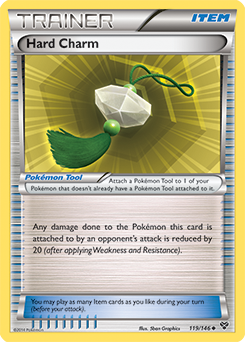
So what about those remaining five cards? Well, I’d leave that up to you. What do you think this deck needs? I’ve purposely excluded Pokemon Tool cards from the list so far because I feel the deck has a number of options available. Muscle Band provides a little extra attack damage, Float Stone gives your Pokemon free retreat, Hard Charm can lessen the damage M Heracross-EX takes. All are good choices, it just comes down to personal preference. You may decide you’d like to run Lysandre for eliminating Benched threats, run extra drawing cards, more consistency cards like Pokémon Fan Club. You may even want to increase the counts of certain cards like Virizion-EX. This list we’ve constructed so far is simply the core essence of the deck, what you choose to do with those last couple slots can really shake up the deck and make it more comfortable for you to play. There’s only one place you’re going to discover what you truly feel fits there, and that’s the final, most important step:
Step Six: Test Like Crazy!
This is it. You have a deck constructed, you know how it works, you know what you’re up against. This is where we can actually play some games of Pokemon TCG! Experience is really the key here. You need to run the deck as much as you can against as many different types of decks as you can. Run different configurations, try different cards. Make note of the games you lose and why you lost them. Does the deck seem to be lagging behind? Does a certain card (or cards) keep foiling your attempts to set up? Change the deck to address those issues, then test again. Play at Leagues, play Pokemon Trading Card Game Online. The key is to just keep playing. The only way to play a deck that wins games is to craft one first.
Deck building is an act of personalization. Your deck is an expression of yourself. It’s the cards you personally feel work best together, based on your personal preferences and experiences. It should be both fun and natural for you to play.
Conclusion
I should conclude by mentioning that this deck isn’t the greatest. It’ll win games now and again, but you’re not going to see many M Heracross-EX in the World Championships this year. The deck simply can’t keep up with some of the high-ranking decks out there. The point of using this deck as an example though was to show the process of taking a relatively non-viable card like M-Heracross and building a deck that augments his strengths, while trying to circumvent his shortcomings to the point we actually end up with a competitive deck.
Applying this process to other, lesser-used cards you feel have potential is exactly how rogue decks are born. It’s how the shifts in the metagame are created. The top decks in the game are never the top decks for very long; it’s best to stay on your feet, keep an open mind, and above all else, don’t be afraid to experiment. You never know when you might come up with the next crazy deck that nobody was expecting. Thanks for reading, and I hope to see you guys soon with another weird deck!
~Alex Hawrylyshyn

